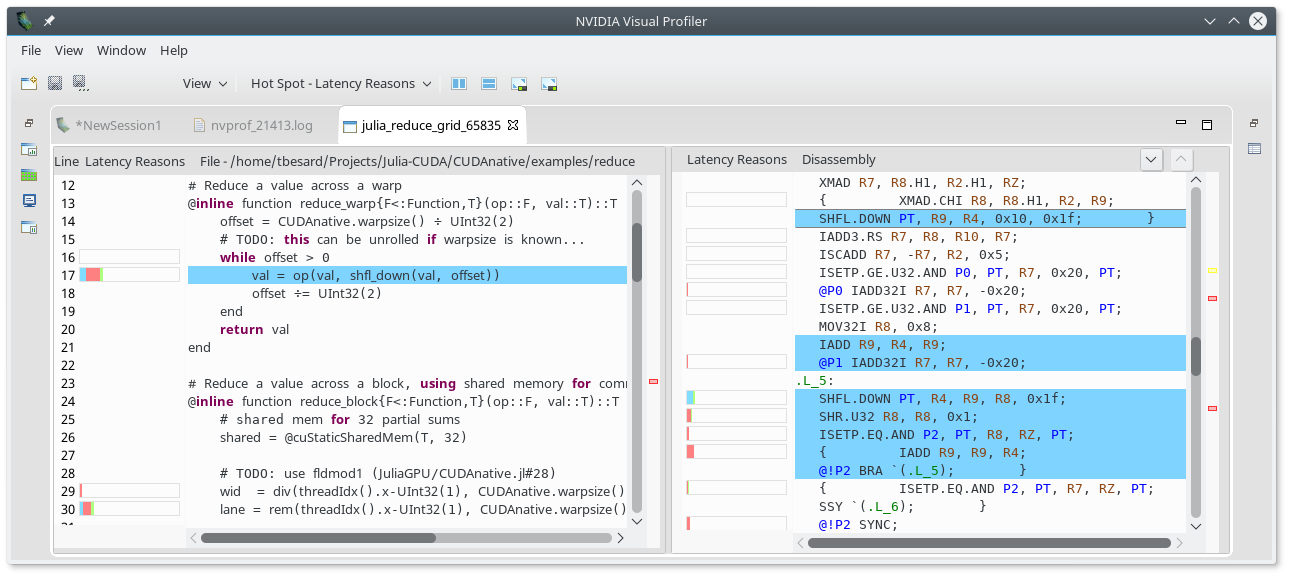CUDA.jl 3.3
Tim Besard
There have been several releases of CUDA.jl in the past couple of months, with many bugfixes and many exciting new features to improve GPU programming in Julia: CuArray now supports isbits Unions, CUDA.jl can emit debug info for use with NVIDIA tools, and changes to the compiler make it even easier to use the latest version of the CUDA toolkit.
CuArray support for isbits Unions
Unions are a way to represent values of one type or another, e.g., a value that can be an integer or a floating point. If all possible element types of a Union are so-called bitstypes, which can be stored contiguously in memory, the Union of these types can be stored contiguously too. This kind of optimization is implemented by the Array type, which can store such "isbits Unions" inline, as opposed to storing a pointer to a heap-allocated box. For more details, refer to the Julia documentation.
With CUDA.jl 3.3, the CuArray GPU array type now supports this optimization too. That means you can safely allocate CuArrays with isbits union element types and perform GPU-accelerated operations on then:
julia> a = CuArray([1, nothing, 3])
3-element CuArray{Union{Nothing, Int64}, 1}:
1
nothing
3
julia> findfirst(isnothing, a)
2It is also safe to pass these CuArrays to a kernel and use unions there:
julia> function kernel(a)
i = threadIdx().x
if a[i] !== nothing
a[i] += 1
end
return
end
julia> @cuda threads=3 kernel(a)
julia> a
3-element CuArray{Union{Nothing, Int64}, 1}:
2
nothing
4This feature is especially valuable to represent missing values, and is an important step towards GPU support for DataFrames.jl.
Debug and location information
Another noteworthy addition is the support for emitting debug and location information. The debug level, set by passing -g <level> to the julia executable, determines how much info is emitted. The default of level 1 only enables location information instructions which should not impact performance. Passing -g0 disables this, while passing -g2 also enables the output of DWARF debug information and compiles in debug mode.
Location information is useful for a variety of reasons. Many tools, like the NVIDIA profilers, use it corelate instructions to source code:

Debug information can be used to debug compiled code using cuda-gdb:
$ cuda-gdb --args julia -g2 examples/vadd.jl
(cuda-gdb) set cuda break_on_launch all
(cuda-gdb) run
[Switching focus to CUDA kernel 0, grid 1, block (0,0,0), thread (0,0,0), device 0, sm 0, warp 0, lane 0]
macro expansion () at .julia/packages/LLVM/hHQuD/src/interop/base.jl:74
74 Base.llvmcall(($ir,$fn), $rettyp, $argtyp, $(args.args...))
(cuda-gdb) bt
#0 macro expansion () at .julia/packages/LLVM/hHQuD/src/interop/base.jl:74
#1 macro expansion () at .julia/dev/CUDA/src/device/intrinsics/indexing.jl:6
#2 _index () at .julia/dev/CUDA/src/device/intrinsics/indexing.jl:6
#3 blockIdx_x () at .julia/dev/CUDA/src/device/intrinsics/indexing.jl:56
#4 blockIdx () at .julia/dev/CUDA/src/device/intrinsics/indexing.jl:76
#5 julia_vadd<<<(1,1,1),(12,1,1)>>> (a=..., b=..., c=...) at .julia/dev/CUDA/examples/vadd.jl:6
(cuda-gdb) f 5
#5 julia_vadd<<<(1,1,1),(12,1,1)>>> (a=..., b=..., c=...) at .julia/dev/CUDA/examples/vadd.jl:6
6 i = (blockIdx().x-1) * blockDim().x + threadIdx().x
(cuda-gdb) l
1 using Test
2
3 using CUDA
4
5 function vadd(a, b, c)
6 i = (blockIdx().x-1) * blockDim().x + threadIdx().x
7 c[i] = a[i] + b[i]
8 return
9 end
10Improved CUDA compatibility support
As always, new CUDA.jl releases come with updated support for the CUDA toolkit. CUDA.jl is now compatible with CUDA 11.3, as well as CUDA 11.3 Update 1. Users don't have to do anything to update to these versions, as CUDA.jl will automatically select and download the latest supported version.
Of course, for CUDA.jl to use the latest versions of the CUDA toolkit, a sufficiently recent version of the NVIDIA driver is required. Before CUDA 11.0, the driver's CUDA compatibility was a strict lower bound, and every minor CUDA release required a driver update. CUDA 11.0 comes with an enhanced compatibility option that follows semantic versioning, e.g., CUDA 11.3 can be used on an NVIDIA driver that only supports up to CUDA 11.0. CUDA.jl now follows semantic versioning when selecting a compatible toolkit, making it easier to use the latest version of the CUDA toolkit in Julia.
For those interested: Implementing semantic versioning required the CUDA.jl compiler to use ptxas instead of the driver's embedded JIT to generate GPU machine code. At the same time, many parts of CUDA.jl still use the CUDA driver APIs, so it's always recommended to keep your NVIDIA driver up-to-date.
High-level graph APIs
To overcome the cost of launching kernels, CUDA makes it possible to build computational graphs, and execute those graphs with less overhead than the underlying operations. In CUDA.jl we provide easy access to the APIs to record and execute these graphs:
A = CUDA.zeros(Int, 1)
# ensure the operation is compiled
A .+= 1
# capture
graph = capture() do
A .+= 1
end
@test Array(A) == [1] # didn't change anything
# instantiate and launch
exec = instantiate(graph)
CUDA.launch(exec)
@test Array(A) == [2]
# update and instantiate/launch again
graph′ = capture() do
A .+= 2
end
update(exec, graph′)
CUDA.launch(exec)
@test Array(A) == [4]This sequence of operations is common enough that we provide a high-level @captured macro wraps that automatically records, updates, instantiates and launches the graph:
A = CUDA.zeros(Int, 1)
for i in 1:2
@captured A .+= 1
end
@test Array(A) == [2]Minor changes and features
CUDA.jl now supports
@atomicmultiplication and division (by @yuehhua)Several statistics functions have been implemented (by @berquist)
The device-side random number generator in is now based on Philox2x, greatly improving quality of randomness (passing BigCrush) while allowing calls to
rand()from divergent threads.Dependent libraries like CUDNN and CUTENSOR are now only downloaded and initialized when they are used.
The
synchronize()function in now first spins before yielding and sleeping, to improve the latency of short-running operations.Several additional operations are now supported on Float16 inputs, such as CUSPARSE and CUBLAS operations, and various math intrinsics.
Kepler support (compute capability 3.5) has been reinstated for the time being.